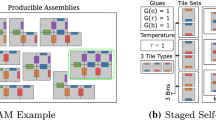Abstract
In this paper, we study the step-wise tile assembly model introduced by Reif (in: Based computers III, vol 48 of DIMACS, 1999) in which shape is assembled in multiple steps. In each step the partially built structure is exposed to a new set of tiles. We show that an N × N square can be assembled in N steps using a constant number of tile types. In general, we show that a constant number of tile types (24) is sufficient to assemble a large class of shapes in n steps, where n is the number of tiles of the shape. This class includes all shapes obtained from any shape by scaling by a factor of 2, in which case only 14 tile types suffices. For general shapes, we show that the tile complexity of this model is related to the monotone connected node search number of a spanning tree of the shape assuming the number of steps is n.

















Similar content being viewed by others
Notes
After personal communication with the authors of Demaine et al. (2008) we were advised that original bound of 16 in the paper should be 52.
References
Abelson H, Allen D, Coore D, Hanson C, Homsy G, Knight TF, Nagpal R, Rauch E, Sussman GJ, Weiss R (2000) Amorphous computing. Commun ACM 43:74–82
Adleman L, Cheng Q, Goel A, Huang M-D, Kempe D, de Espanes PM, Rothemund P (2002) Combinatorial optimization problems in self-assembly. In: Proceedings of STOC, Montreal, Canada, pp 23–32
Aggarwal G, Cheng Q, Goldwasser MH, Kao M-Y, Espanes PM, Schweller RT (2005) Complexities for generalized models of self-assembly. SIAM J Comput 34(6):1493–1515
Barriere L, Fraigniaud P, Santoro N, Thilikos DM (2003) Connected and internal graph searching. In: 29th workshop on graph theoretic concepts in computer science (WG). LNCS, vol 2880. Springer, Heidelberg, pp 34–45
Best MJ A bound on connected pathwidth. Manuscript
Demaine ED, Demaine ML, Fekete SP, Ishaque M, Rafalin E, Schweller RT, Souvaine DL (2008) Staged self-assembly: nanomanufacture of arbitrary shapes with O(1) glues. Nat Comput 7(3):347–370
Fraigniaud P, Nisse N (2008) Monotony properties of connected visible graph searching. Inf Comput 206(12):1383–1393
Gomez-Lopez M, Preece J, Stoddart J (1996) The art and science of self-assembling molecular machines. Nanotechnology 7:183–192
Kirousis LM, Papadimitriou CH (1985) Interval graphs and searching. Discr Math 55(1):181–184
Kirousis L, Papadimitriou C (1986) Searching and pebbling. Theor Comput Sci 47(2):205–218
LaBean T, Yan H, Kopatsch J, Liu F, Winfree E, Reif JH, Seeman N (2000) Construction, analysis, ligation, and self-assembly of DNA triple crossover complexes. J Am Chem Soc 122:1848–1860
Maňuch J, Stacho L, Stoll C (2009) Step-assembly with a constant number of tile types. In: Proceedings of the 20th international symposium on algorithms and computation (ISAAC, Hawaii, 2009), number 5878 in LNCS, pp 954–963
Mao C, LaBean TH, Reif J, Seeman N (2000) Logical computation using algorithmic self-assembly of DNA triple-crossover molecules. Nature 407:493–496
Reif JH (1999) Local parallel biomolecular computing. In: DNA based computers III, vol 48 of DIMACS. American Mathematical Society, Providence, pp 217–254
Rothemund PWK, Winfree E (2000) The program-size complexity of self-assembled squares. In: Proceedings of STOC, New York, pp 459–468
Rothemund P, Papadakis N, Winfree E (2004) Algorithmic self-assembly of DNA Sierpinski triangles. PLoS Biol 2:2041–2053
Seeman N (1998) DNA nanotechnology: novel DNA constructions. Annu Rev Biophys Biomol Struct 27:225–248
Summers SM (2012) Reducing tile complexity for the self-assembly of scaled shapes through temperature programming. Algorithmica 63(1–2):117–136
Winfree E, Yang X, Seeman N (1996) Universal computation via self-assembly of DNA: some theory and experiments. In: Proceedings of the second annual meeting on DNA based computers, pp 191–214
Winfree E, Liu F, Wenzler LA, Seeman NC (1998) Design and self-assembly of two dimensional DNA crystals. Nature 394:539–544
Author information
Authors and Affiliations
Corresponding author
Rights and permissions
About this article
Cite this article
Maňuch, J., Stacho, L. & Stoll, C. Step-wise tile assembly with a constant number of tile types. Nat Comput 11, 535–550 (2012). https://doi.org/10.1007/s11047-012-9321-1
Published:
Issue Date:
DOI: https://doi.org/10.1007/s11047-012-9321-1




